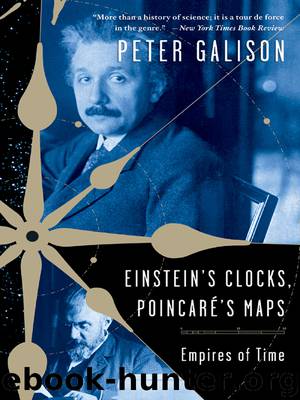Einstein's Clocks and Poincare's Maps by Peter Galison

Author:Peter Galison
Language: eng
Format: epub
Publisher: W. W. Norton & Company
Published: 2013-03-10T16:00:00+00:00
Figure 4.4 Hunting the Ether. With a remarkable series of experiments, Albert Michelson sought to measure the earth’s motion through the elusive ether. In the 1881 device shown here, he launched a beam of light from a that was split by a half-silvered mirror at b: one-half of the ray reflected off d and into the eyepiece e. The other half of the ray penetrated the mirror at b, reflected from c, and was then bounced from b to the eyepiece e. At the eyepiece the two rays interfered with each other, showing the observer a characteristic pattern of light and dark. If one wave was delayed—by so little as a part of a wavelength of light—this pattern would visibly shift. So if the earth really was flying through the ether, then the “ether wind” would affect the relative time it took for the two beams to make their round-trips (the relative phase of the two waves would shift). Consequently, Michelson fully expected that if he rotated the apparatus, he would see a change in the interference patterns of the two rays. But no matter how he twisted his staggeringly sensitive instrument, the dark and light patterns did not budge. To Lorentz and Poincaré, this meant that the interferometer arms—like all matter—were contracted by their rush through the ether in just such a way as to hide the effect of the ether. To Einstein it was one more suggestive piece of evidence that the very idea of the ether was “superfluous.” SOURCE: MICHELSON, “THE RELATIVE MOTION OF THE EARTH AND LUMINIFEROUS ETHER,” AMERICAN JOURNAL OF SCIENCE, 3RD SERIES, VOL. XXII, NO. 128 (AUGUST 1881), P. 124.
Indeed, Michelson thought he had the ether cornered. For if there truly was an ether wind, then the round-trip time for a light beam should change, depending on whether the light was being sent across or into the wind. But rotating the apparatus showed not the slightest twitch of the interference dark spot; to an extraordinary degree of accuracy, it seemed that no motion through the ether could be detected by optical means. Though Michelson saw his efforts to find the ether as a dismal failure, other physicists, including Lorentz, were moved to theorize.
Taking Michelson’s null result into account, in 1892 Lorentz assumed the existence of a static ether, and introduced the startling notion that any object moving through the ether contracted in its direction of travel. Bizarre as this “Lorentz contraction” sounded, the gambit worked, in the sense that a judicious choice of this contraction factor exactly compensated for the effect of the putative ether wind. Lorentz’s contraction explained why high-precision experiments—even the extraordinary Michelson interferometer—would be powerless to uncover the effects of the etherial breeze on optical phenomena.
Remarkably, Lorentz’s contraction hypothesis was not enough. In the course of demonstrating that all optical phenomena could be described in approximately the same way, he introduced in 1895 a second innovation, a fictional “local time.”60 Lorentz’s idea was that there was one true physical time, ttrue. True time was the appropriate time to use for objects at rest in the ether.
Download
This site does not store any files on its server. We only index and link to content provided by other sites. Please contact the content providers to delete copyright contents if any and email us, we'll remove relevant links or contents immediately.
The Complete Stick Figure Physics Tutorials by Allen Sarah(6638)
Secrets of Antigravity Propulsion: Tesla, UFOs, and Classified Aerospace Technology by Ph.D. Paul A. Laviolette(3450)
Thing Explainer by Randall Munroe(3328)
The River of Consciousness by Oliver Sacks(2992)
The Order of Time by Carlo Rovelli(2714)
I Live in the Future & Here's How It Works by Nick Bilton(2524)
How To by Randall Munroe(2476)
A Brief History of Time by Stephen Hawking(2473)
The Great Unknown by Marcus du Sautoy(2186)
What If?: Serious Scientific Answers to Absurd Hypothetical Questions by Randall Munroe(2170)
Blockchain: Ultimate Step By Step Guide To Understanding Blockchain Technology, Bitcoin Creation, and the future of Money (Novice to Expert) by Keizer Söze(2137)
Midnight in Chernobyl by Adam Higginbotham(2078)
Networks: An Introduction by Newman Mark(1998)
The Meaning of it All by Richard Feynman(1909)
Easy Electronics by Charles Platt(1864)
The Tao of Physics by Fritjof Capra(1850)
When by Daniel H Pink(1777)
Midnight in Chernobyl: The Untold Story of the World's Greatest Nuclear Disaster by Adam Higginbotham(1775)
Introducing Relativity by Bruce Bassett(1755)
